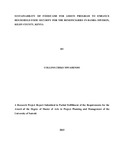| dc.description.abstract | Achieving food security in its entirety continues to be a challenge not only for the developing
nations, but also for the developed world. The only difference lies in the magnitude of the
problem in terms of its severity and proportion of the population affected. In most countries, the
problem is alleviated by providing targeted food security interventions, including food aid in the
form of direct food relief, food stamps, and cash or indirectly through subsidized food
production. Bamba division in Kilifi County has been under such food security interventions and
in particular Food for Assets/Cash for Assets program among other food-based interventions
such as School Feeding Programme, Supplementary Feeding Programme and Food by
Prescription. However, despite all these efforts, Bamba as a division has remained food insecure
with her populace vulnerable to extreme hunger and poverty due to natural hazards, notably,
prolonged and sporadic droughts. In this regard, the study sought to investigate the factors that
influence the sustainability of Food/Cash for Assets program to enhance beneficiaries’ food
security through the program implemented by the Government of Kenya and WFP through
World Vision Kenya. The research zeroed in on the demographic characteristics of the
beneficiaries (gender, age, family size and education levels); the income levels of beneficiaries;
weather conditions; beneficiary participation and capacity building of the beneficiaries. A
combination of quantitative and qualitative techniques was used to collect information from a
sample of 143 program beneficiaries from 7 out of the 14 Food/Cash for Assets sites in Bamba.
These were selected using a combination of methods including the table for determining sample
size, stratified random sampling, systematic random sampling and simple random sampling
techniques, from a target population of the 2740 household representatives. A different but
similar group from the neighbouring division was used for the validation process of the data
collection instruments and determining their validity and reliability. After gathering all the
information, data was organized, coded and analyzed using Statistical Package for Social
Scientists (SPSS) and subsequently presented using cross-tabulations, frequency and percentage
tables. The findings were summarized, discussed and conclusions made. Based on the findings
and conclusions, recommendations were proposed for each objective, finding and conclusion
made. Ultimately, further studies were suggested to unearth other factors that also influence
success of community development projects and their sustainability in the same locale. | |

